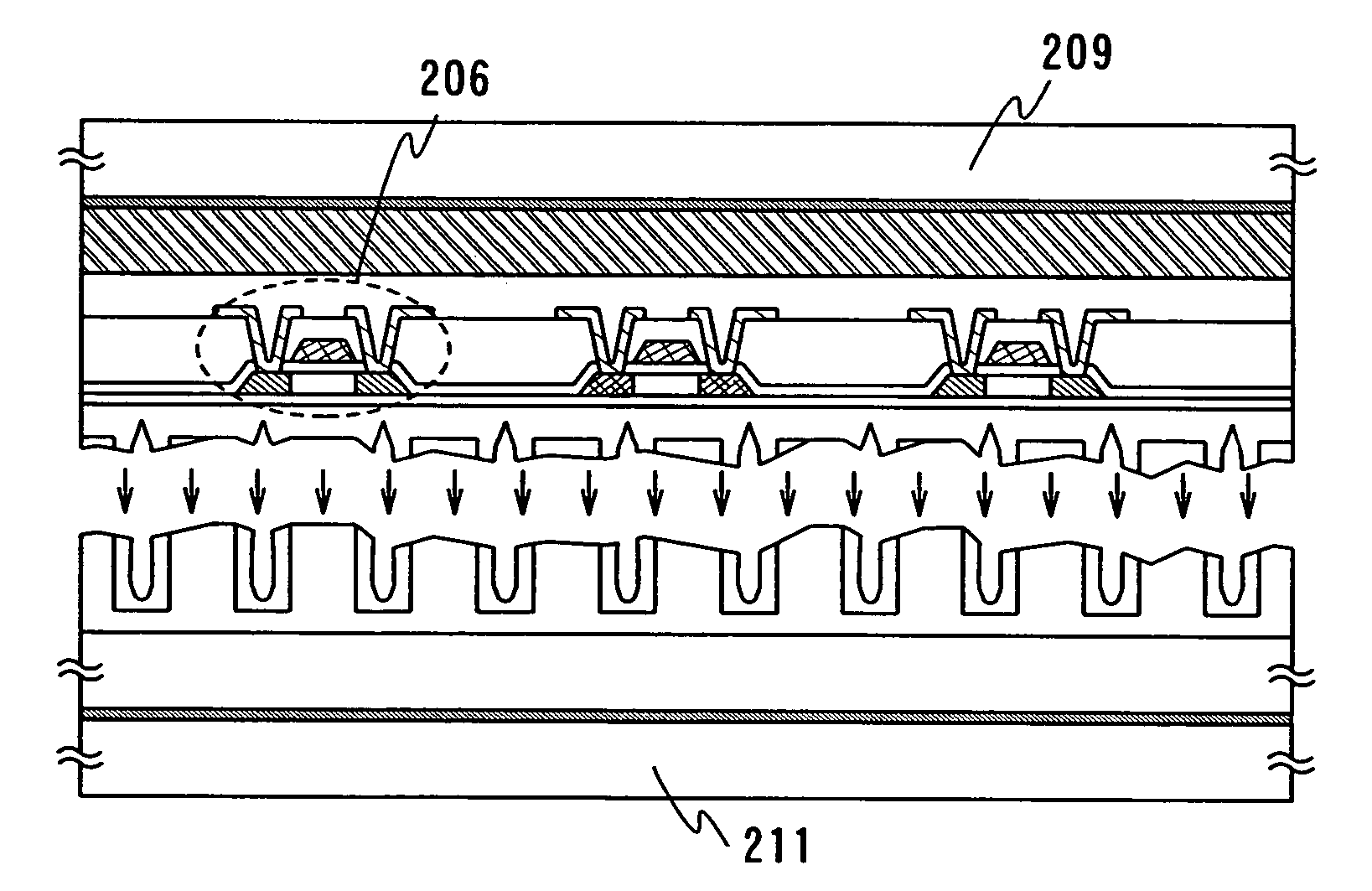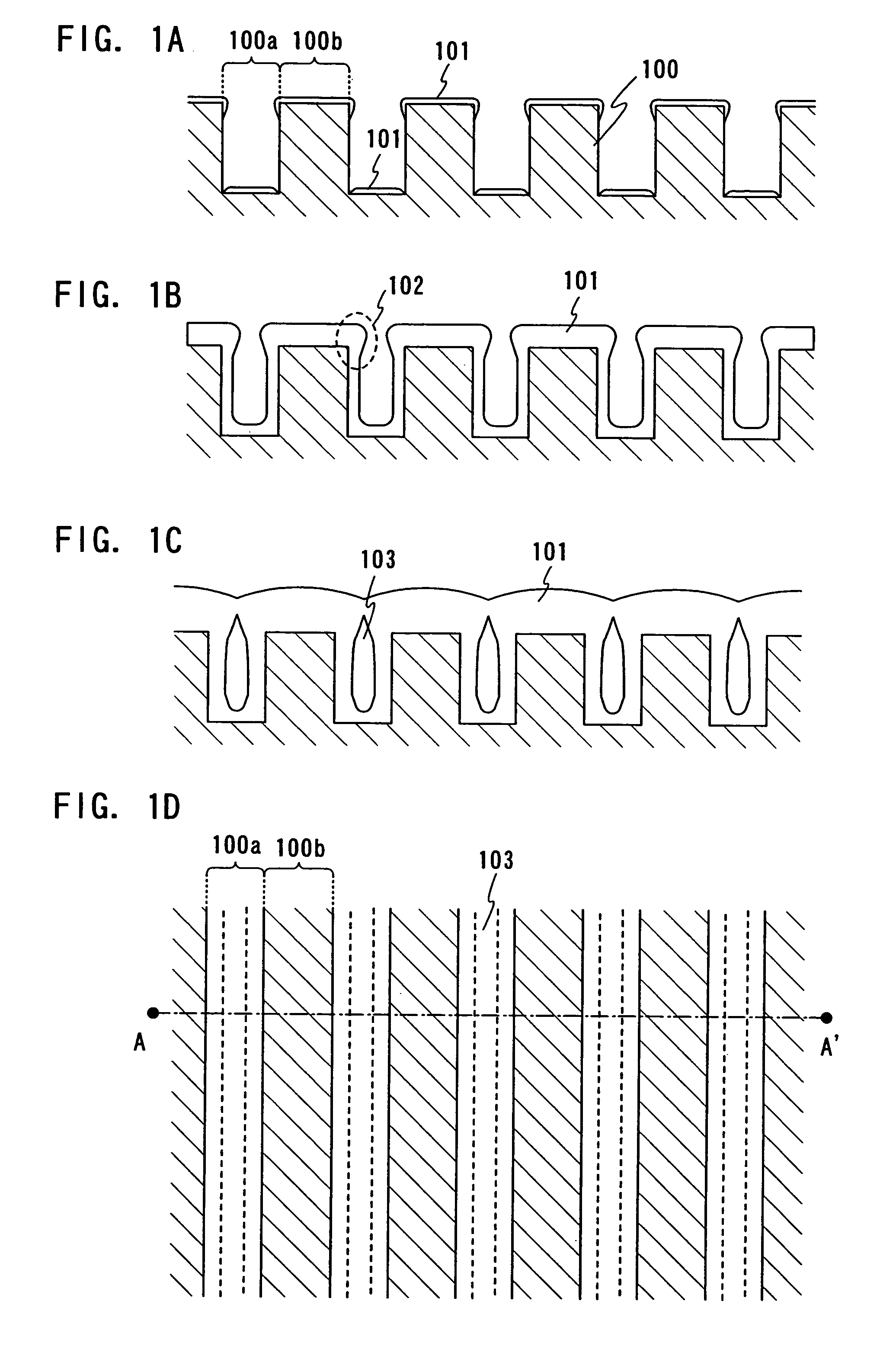Method for peeling off semiconductor element and method for manufacturing semiconductor device
a technology of peeling off semiconductor elements and manufacturing methods, which is applied in the direction of semiconductor devices, electrical devices, transistors, etc., can solve the problems of reducing the thickness of glass substrates, limiting the formation of larger voids, and the heat resistance of plastic substrates not high enough to withstand heat treatment, so as to achieve the effect of more volume and easy formation
- Summary
- Abstract
- Description
- Claims
- Application Information
AI Technical Summary
Benefits of technology
Problems solved by technology
Method used
Image
Examples
embodiment mode 1
[0035]Explanation is hereinafter made on a manufacturing method of a semiconductor device by using a peeling method according to the invention.
[0036]First, a first base layer 201 having recessed portions and projective portions is formed on a first substrate 200 as shown in FIG. 2A. The first substrate 200 can be formed of a material which is capable of withstanding a heat treatment in subsequent steps. For example a quartz substrate, a silicon substrate, a glass substrate such as of barium borosilicate glass or aluminum borosilicate glass, a metal substrate, stainless substrate and the like are available.
[0037]In this embodiment mode, a silicon oxide layer is used for the first base layer 201. However, a material for the first base layer 201 is not limited to this, and an insulating layer such as silicon nitride layer and silicon nitride oxide layer or a metal layer such as W and Mo may also be used. A method for forming the recessed portions and projective portions will be describ...
embodiment mode 2
[0076]Explanation will be hereinafter made on a manufacturing method of a first base layer which has recessed portions and projective portions and is formed of an insulating layer. Needless to say, the manufacturing method and structure of the first base layer described below is just an example, and the invention is not limited this.
[0077]First, a first insulating layer 602 is formed on a first substrate 601 as shown in FIG. 8A. A silicon oxynitride layer is used for the first insulating layer 602 in this embodiment mode, though the invention is not limited to this and other insulating layer can be used as long as it has high etching selectivity relative to a second insulating layer formed thereon. In this embodiment mode, SiH4 and N2O are deposited by CVD to have a film thickness of 50 to 200 nm to form the first insulating layer 602. The first insulating layer 602 may have either a single layer structure or a laminated structure of a plurality of insulating layers.
[0078]Next, a se...
embodiment mode 3
[0085]Explanation will be hereinafter made on a peeling method of the invention when using a metal layer for a first base layer.
[0086]First, a first base layer 801 having recessed portions and projective portions is formed on a first substrate 800 as shown in FIG. 10A. As well as the case shown in Embodiment Mode 1, in which an insulating layer is used for a first base layer, the first substrate 800 can be formed of a material which is capable of withstanding a heat treatment in subsequent steps. The first base layer 801 is formed of W (tungsten) in this embodiment mode. A metal layer is deposited on the first substrate 800 by sputtering and patterned in order to form the first base layer 801. The first base layer 801 may have either a single layer structure or a laminated structure of metal layers.
[0087]The form of the recessed portions and projective portions can be appropriately determined by a designer in accordance with a deposition method and a peeling method. In this embodime...
PUM
 Login to View More
Login to View More Abstract
Description
Claims
Application Information
 Login to View More
Login to View More - R&D
- Intellectual Property
- Life Sciences
- Materials
- Tech Scout
- Unparalleled Data Quality
- Higher Quality Content
- 60% Fewer Hallucinations
Browse by: Latest US Patents, China's latest patents, Technical Efficacy Thesaurus, Application Domain, Technology Topic, Popular Technical Reports.
© 2025 PatSnap. All rights reserved.Legal|Privacy policy|Modern Slavery Act Transparency Statement|Sitemap|About US| Contact US: help@patsnap.com



